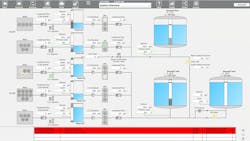There is more to today’s processing automation systems than meets the eye, with plenty of moving parts behind the scenes. The many elements in play include extensive electrical distribution and motor control, a wide array of process instrumentation, detailed control logic executing in milliseconds and wiring and networking systems interconnecting it all. But in most applications, the human-machine interface (HMI) or supervisory control and data acquisition (SCADA) graphical displays form the highly visible “face” of the entire operation.
With the rapid growth of wireless networking, industrial internet of things (IIoT) and mobile device technology, there are more ways than ever to present HMI/SCADA graphics for facility monitoring and control. An operator might interact with a cell phone, a tablet, a dedicated plant floor operator interface terminal, a control room PC-based system and a cloud-hosted web dashboard, all during a single shift, and user needs in each case may be quite different.
Because it is so common for operators to interact with multiple machines and devices, it is more critical than ever to ensure consistent and straightforward end user experiences from one interface to the next. Otherwise, it can be difficult for personnel to work efficiently, leading to operational failures and unplanned downtime, or worse, safety incidents. Adding to the complication is the fact that expanded HMI/SCADA connectivity demands robust cybersecurity precautions across the board, and many markets call for industry-specific design practices. For example, water/wastewater municipalities and other utilities often have different needs than a manufacturing factory or a high-tech pharma or semiconductor facility (Figure 1).
Developers, including original equipment manufacturers (OEMs) and systems integrators (SIs) employed by end users, are tasked with creating clear, effective and usable graphics. There are many approaches, a lot of personal preferences and no universal clear-cut answer to span the needs of all industries and users. However, there are many reasons why SIs are ideally positioned to efficiently deliver the consistent graphics end users need and want, making equipment simpler to operate and easier to troubleshoot.
Theory meets practice
The original operator interface for early digital systems consisted of buttons, lights and gauges. These were expensive, difficult to install, consumed a lot of control panel space and complicated any upgrades or modifications. Graphical HMI/SCADA devices and systems solved these and other problems, and opened up a universe of design possibilities.
There have been two predominant lines of thought over the years with regards to HMI/SCADA graphic design best practices:
- Traditional graphics (Figure 2): Attempt to physically depict the process like a flow diagram to the greatest extent possible, showing pumps, valves, pipelines and so forth. These often incorporate a lot of color, distracting animations, excessive information (especially numeric values) and do not follow any recognized standard or even convention.
- Situational awareness (high-performance) graphics (Figure 3): A newer style characterized by informative yet minimalist, streamlined representations, using color sparingly, and only to draw attention to anomalies. These align with the ISA 101 HMI standard. This design style is sometimes referred to as “boring”, but provides the benefit that any abnormal or potentially problematic events are clearly visible.
End users determine the variety and priority of their needs, although sometimes they pursue conflicting ideas. They may express their needs by referencing existing samples or creating requirement and specification documents, or in other less formal ways. Some typical needs involve:
- Accuracy: Operations want graphics to accurately represent process flow and equipment orientation as they are in field.
- Simplicity: In support of easy training, informed decision-making and rapid operation.
- Economics: Most users recognize that basic and standardized designs are less expensive to develop, deploy and support.
- Consistency: Many end users possess significant investments in current systems, and any new work must match existing for reasons of operator familiarity. This design “inertia” may reduce or preclude the adoption of newer graphic styles, but many times is a valid approach.
- Preference: Some desire very minimal or basic operational access, while others prefer exhaustive control functionality.
- Accessibility: An influx of HMI/SCADA options, especially mobile, is driving the need for dynamic dashboards and graphical representations, scalable over a wide range of display sizes and orientations.
- Image: In some cases, end users show off plant graphics during public-facing tours, leading them to invest in “showcase” big-screen control room displays.
In general, many SIs are seeing the end user market preference shift away from traditional graphics and toward situational awareness graphics. However, for a variety of reasons, many users still prefer traditional HMI graphics in part or in full. It is the job of developers and SIs to reconcile the needs of end users with the benefits of workable standards, guiding teams toward optimal solutions.
An effective path forward
Users and developers alike understand the massive benefits of workable standards and libraries. Because of their role performing automation and HMI/SCADA development across many industries and technologies, SIs are usually best positioned to help navigate the path of graphics development (Figure 4).
SIs generally prefer the speed, simplicity, reliability and consistency of following high-performance standards and re-using library objects to the greatest extent possible. The move of HMI/SCADA systems toward standardization mimics similar shifts in both consumer and IT worlds. By standardizing graphics, navigation and machine control interfaces throughout an enterprise — even among different PLC and machine manufacturers when possible — operator training efforts and propensity for errors are greatly reduced. Standardization enables rapid deployment, simplifies operation and minimizes support requirements because developers can replicate proven functionality.
From a commercial standpoint, project deliverables based on specifications are the best way to obtain clarity and define expectations for all parties involved. But as a practical manner, even highly specified projects will benefit when the stakeholders — including engineers, operators and maintenance personnel — are involved with workshops held early in the project.
Some SIs possess a wealth of experience in a particular industry or small group of industries, and others span many industries. Regardless, SIs can provide valuable insight because they execute many HMI/SCADA projects on a variety of automation hardware and software platforms using various technologies.
For end users with specifications in hand, workshops draw out the information in an even more complete “hands-on” manner, and an SI can provide input to ensure end user ideas are in line with modern industry conventions. For end users with less specific ideas, an SI partner can present options and explain the comparative benefits. SIs such as Tesco provide additional value with the ability to suggest best practices, and their extensive knowledge in specific industries, such as water/wastewater, helps them gauge the effort required, bid it properly so there are no surprises and execute the work effectively.
Leveraging libraries
Evaluating HMI/SCADA standards and forging them into production libraries is a team effort. In particular, libraries require a degree of rigor to develop, apply and maintain, especially when they must adapt to multiple makes and models of controllers. Libraries should contain actual programming and configuration objects, but they may also include procedures and a style guide to detail work execution. Experienced SIs are usually equipped to build up libraries from scratch, as they understand the needs of their customers.
Library objects should work with minimal configuration, and are about more than just the look and feel. By standardizing equipment data behind the scenes in addition to visual presentation, libraries ease integration with process historians and higher-level enterprise systems, such as asset management and manufacturing execution systems.
Some automation product vendors provide brand-specific libraries which extend between HMI/SCADA and PLC. This type of vendor-specific library provides assurances of compatibility within the selected product family, and if both the graphical and PLC library objects are used in conjunction, development and testing time is minimized. However, some users may run into potential vendor library downsides, such as limited connectivity with third-party products, heavy resource usage or inflexibility in cases where the manufacturer recommends against modifying objects.
Third-party HMI/SCADA solutions frequently offer graphical libraries. These provide standardized graphical objects which can be tailored to end user needs. However, these objects must be correlated with separate PLC objects to provide sought-after connectivity with multiple automation platforms. Some end users prefer this third-party HMI/SCADA objects approach, while others prefer to remain within a single vendor ecosystem.
Workshop wins
Tesco recently completed a SCADA upgrade project with a water/wastewater client. This agency had been struggling with an aging SCADA system, end-of-life PLCs and a failing communication infrastructure. Although they knew an upgrade was necessary, they had limited ideas of the best approach because their familiarity was limited almost exclusively to the legacy systems they had in place.
Immediately upon project kickoff, Tesco began facilitating workshops with this client to present graphical options. One possibility was a brute-force approach, which would involve recreating all existing systems and traditional graphics with new hardware and software. But after a great deal of deliberation in the workshops, the agency chose to migrate toward modern situational awareness standards in the interest of improving operations. The workshops also highlighted existing issues, concerns and pain points so the SI team would specifically know what to address in the new design.
With agreed-upon graphics and architecture, the project was on track for efficient execution. The SI delivered a fully templatized system to this client, with PLC programs and a SCADA application developed using standardized library objects. Because of the standards on which the system was built, all future additions or modifications to existing sites will require only minimal PLC and SCADA configuration efforts. And in many years when this SCADA hardware and software reaches end of life, the agency will have clearer options to remain with their current platform or migrate to another. Developing applications in a templatized manner leads to easier and better-controlled migrations and adjustments in the future.
SI-sourced solutions
Use of an HMI/SCADA system is often the most prominent interaction end users experience with their industrial automation and process control systems. Effective graphics must not only be aesthetically pleasing, but they also need to clearly convey important information to help operators work efficiently. Today’s users have extensive web browser and mobile device experience, and are likely to have more sophisticated expectations than in years past.
Because of the significant experience SI developers acquire working in various industries and with many technologies, they are well-positioned to help their end user and OEM clients squeeze the most value possible from new and retrofit HMI/SCADA projects. In particular, SI partners support their clients by leading workshops built on knowledgebases of specifications, standards and best practices. This helps ensure applications meet end user needs, and are easy and enjoyable to use.
Joshua Choe is SCADA engineering manager at Tesco Controls. Joshua is focused on developing SCADA and associated best practices, and has more than 20 years of experience designing and implementing process control systems for water/wastewater and other industries.
About the Author
Joshua Choe
SCADA engineering manager at Tesco Controls
Joshua Choe is SCADA engineering manager at Tesco Controls. Joshua is focused on developing SCADA and associated best practices, and has more than 20 years of experience designing and implementing process control systems.



